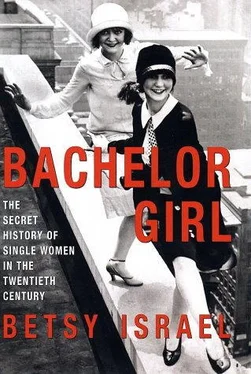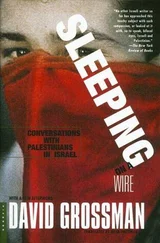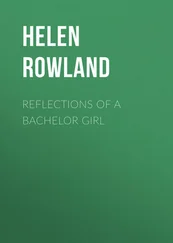Twentieth century: Edith Wharton, Sanctuary (New York: Scribner’s, 1903); Edna Ferber, The Girls (New York: P. F. Collier & Son, 1921); Anne Parrish, The Perennial Bachelor (London: Harper Brothers, 1925); Margaret Ayers Barnes, Within This Present (Boston: Houghton Mifflin, 1933) and Edna, His Wife (Boston: Houghton Mifflin, 1935); Josephine Lawrence, But You Are Young (Boston: Little, Brown, 1940), a novel on the “new dependency,” a trend also known as “the piggy family,” and The Tower of Steel (Boston: Little, Brown, 1943), the story of four single girls in the city, an early version of this familiar genre (one is in flight from her piggy family—“the indecent demands made upon her spiritual privacy”—one commits suicide, and so on); Sophia Belzer Engstrand, Wilma Rogers (New York: Dial Press, 1941) and Miss Munday (New York: Dial Press, 1940); Zona Gale, Faint Perfume (New York: D. Appleton and Co., 1923); Fanny Hurst, The Lonely Parade (New York: Harper Brothers, 1942); Dawn Powell, A Time to Be Born (New York: Scribner’s, 1942); Edith Wharton, Ethan Frome (New York: Scribner’s, 1911); for the Lily Briscoe character, Virginia Woolf, To the Lighthouse (New York: Harcourt, Brace & World, 1927); Charlotte Perkins Gilman, Herland 1909–1912; New York: Pantheon, 1979) and The Yellow Wallpaper (1892; New York: Bantam Classics, 1989); Betty Smith, A Tree Grows in Brooklyn (New York/London: Governeur, D. Appleton and Co., 1943), for the two spinster piano teachers who live off the snacks brought to them or accidentally left by their piano students. Esther Forbes, Miss Marvel (Boston: Houghton Mifflin, 1935); Sylvia Ashton-Warner, Spinster (New York: Simon & Schuster, 1958).
Theodore Pratt, Miss Dilly Says No (New York: Duell, Sloane and Pearce, 1945), a little-known spinster novel about a movie-company secretary who writes terrible scripts no one bothers to finish—they’re as dull as she is! Then she writes a memoir of her life as a movie-company secretary, never thinking it might be published. It is. Be comes a best-seller. And so the film companies, her own especially, fight over the rights to make the movie of how idiotic they all are. Miss Dilly, locked up in a hotel room with a starlet bodyguard, repeatedly says “no.” Muriel Spark, The Girls of Slender Means (New York: Knopf, 1963) and The Prime of Miss Jean Brodie (New York: Dell, 1966); Mary McCarthy, The Company She Keeps (1942; New York: Harcourt Brace Jovanovich, 1970) and The Group (London: Weidenfeld and Nicolson, 1963); Alison Lurie, Foreign Affairs (New York: Avon, 1985); Anita Brookner, Look at Me (New York; Pantheon, 1983), Hotel Du Lac (New York: Pantheon, 1984), Family and Friends (New York: Pocket, 1985), and Brief Lives (New York: Random House, 1990); Brian Moore, The Lonely Passion of Judith Hearne (Boston: Little, Brown, 1955).
Periodicals:
“The Old Maid of the Family—A Sketch of Human Life,” Atheneum, no. 3 (January 1830); J. A. Turner, “Link Not Thy Fate to His,” Peterson’s (Apr. 1859); “A Woman Alone: Catharine Maria Sedgwick’s Spinsterhood in Nineteenth-Century America,” New England Quarterly, vol. 51 (1978); Elizabeth Meriweather Gilmer, “The Unglorified Spinster,” Cosmopolitan (May 1907); Francis Power Cobbe, “What Shall We Do With Our Old Maids?” Fraser’s, no. 66, (1862); “Why Is Single Life Becoming More General?” The Nation (1868); Molly Haskell, “Paying Homage to the Spinster,” The New York Times Magazine (May 1988).
The cult of true womanhood/domesticity:
Barbara Welter, “The Cult of True Womanhood, 1820–1860,” American Quarterly, no. XVII (1966); Nancy F. Cott, The Bonds of Womanhood: “Woman’s Sphere” in New Eng land, 1780–1835 (New Haven: Yale University Press, 1977); Kathryn Kish Sklar, Catherine Beecher: A Study in American Domesticity (New Haven: Yale University Press, 1973); Susan Strasser, Never Done: A History of American Housework (New York: Pantheon, 1982); Glenna Matthews, Just a Housewife: The Rise and Fall of Domesticity in America (New York: Oxford University Press, 1987).
Memoirs and essays:
Marian Governeur, As I Remember: Recollections of American Society During the Nineteenth Century (New York: D. Appleton and Co., 1911); Domingo Sarmiento, Michael Rockland, ed. and trans., Travels in the United States in 1847 (Princeton, N.J.: Princeton University Press, 1970); Elizabeth Lynn Linton, The Girl of the Period and Other Social Essays (London: Richard and Bentley, 1883) and Modern Women and What Is Said of Them (New York: Redfield, 1868); Natalie Dana, Young in New York: A Memoir of a Victorian Girlhood (Garden City, N.Y.: Doubleday, 1963); Hazel Hunton, Pantaloons and Petticoats: The Diary of a Young Woman (New York: Field, 1950); Edith Wharton, A Backwards Glance (New York: D. Appleton and Co., Century, 1934).
CHAPTER 2: THE SINGLE STEPS OUT
On working women in general and their economic status in the United States:
Lynn Y. Weiner, From Working Girl to Working Mother: The Female Labor Force in the United States, 1820–1980 (Chapel Hill: University of North Carolina Press, 1985); Alice Kessler Harris, History of Wage Earning Women in the United States (New York: Oxford University Press, 1982); Claudia Goldin, Understanding the Gender Gap: An Economic History of American Women (New York: Oxford University Press, 1990). On male attitudes about organized female labor, specifically the idea that men, not women, had to support what would be recognized as a “family,” see Martha May, “Bread Before Roses: American Workingmen, Labor Unions, and the Family Wage,” part of the larger, very useful Women, Work and Protest: A Century of U.S. Women’s Labor History, Ruth Milkman, ed. (New York: Routledge Publishing, 1985); Barbara Mayer Wertheimer, We Were There: The Story of Working Women in America (New York: Pantheon, 1977).
On immigration:
Hasia R. Diner, Erin’s Daughters in America: Irish Immigrant Women in the Nineteenth Century (Baltimore: Johns Hopkins University Press, 1983); Sidney Stahl Steinberg, The World of Our Mothers: The Lives of Jewish Immigrant Women (Chapel Hill: University of North Carolina Press, 1988); Hutchins Hapgood, The Spirit of the Ghetto: Studies of the Jewish Quarter in New York (1902; Cambridge: Harvard University Press, 1967); Maxine Seller, ed., Immigrant Women (Philadelphia: Temple University Press, 1981); portions of Susan Ware, ed., Modern American Women: A Documentary History (Chicago: Dorsey, 1989); the classic, still viable New York story, Jacob Riis, How the Other Half Lives (New York: Scribner’s, 1890), and Robert Hunter, Poverty (New York: Grosset & Dunlap, 1904), about Chicago; Henry Roth, Call it Sleep (New York: Random House, 1937).
Factory life and domestic service:
An extraordinary overview of women working in nineteenth-century New York is Christine Stansell, City of Women (New York: Knopf, 1986). The book tracks the long climb up from piece or “out” work to factory work (and includes a fascinating discus sion of how one patriarchal system—in the home—was simply substituted with another in the factory). It is invaluable as a study of Bowery culture, the rackets, prostitution, and attitudes about domestic work. Virginia Penny’s original Employments of Women, A Cyclopedia of Women’s Work: How Women Can Make Money Married or Single (Boston: Walker, Wise, 1863) literally lists the thousands of jobs a woman did or might do during the Civil War era. If a woman earned a dime doing it, it’s in here. Kathy Peiss, Cheap Amusements: Working Women and Leisure in Turn-of-the-Century New York (Philadelphia: Temple University Press, 1986) is the best overall examination of the “culture of commercial leisure” (her phrase) and the dangers of the new, unsupervised world of dance halls and amusement parks and the practice of treating.
Читать дальше












